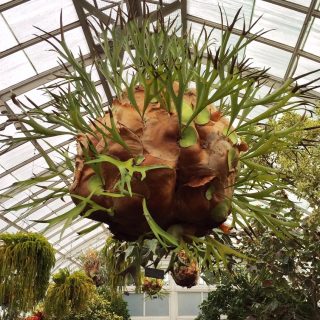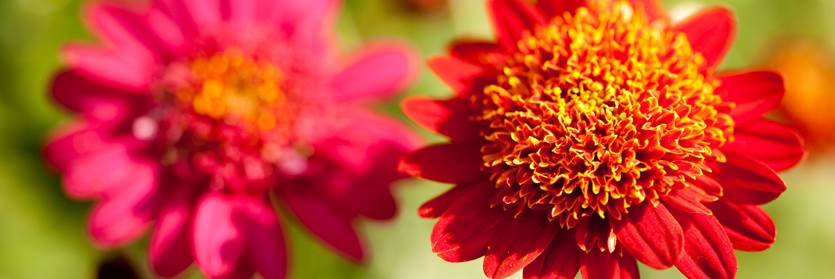Inside The New York Botanical Garden
Posted in From the Library on May 17 2018, by Esther Jackson
Esther Jackson is the Public Services Librarian at NYBG’s LuEsther T. Mertz Library where she manages Reference and Circulation services and oversees the Plant Information Office. She spends much of her time assisting researchers, providing instruction related to library resources, and collaborating with NYBG staff on various projects related to Garden initiatives and events.
 This week’s book review is a #ThrowBackThursday to the popular classic The Know Maintenance Perennial Garden. Written in 2014 by Roy Diblik for Timber Press, the text is a favorite of gardeners who love perennials. Diblik, who worked closely with designer Piet Oudolf on the Lurie Garden in Chicago, has brought his wisdom and knowledge to the public with Know Maintenance. Each of the 62 plans in this work are based on a 10’x14′ grid that is modular in design, offering home gardeners many combinations and plants to suit their landscape and needs, regardless of whether their space is larger or smaller than the example grid. The plans are inspired by works of art as well as existing gardens (for example, Monet, Great Dixter, and Swarthmore College), and are divided into two sections for areas with sun and shade. In addition, plant profiles for 74 plants offer readers suggestions for different plants to use in existing gardens or as a part of new plantings.
This week’s book review is a #ThrowBackThursday to the popular classic The Know Maintenance Perennial Garden. Written in 2014 by Roy Diblik for Timber Press, the text is a favorite of gardeners who love perennials. Diblik, who worked closely with designer Piet Oudolf on the Lurie Garden in Chicago, has brought his wisdom and knowledge to the public with Know Maintenance. Each of the 62 plans in this work are based on a 10’x14′ grid that is modular in design, offering home gardeners many combinations and plants to suit their landscape and needs, regardless of whether their space is larger or smaller than the example grid. The plans are inspired by works of art as well as existing gardens (for example, Monet, Great Dixter, and Swarthmore College), and are divided into two sections for areas with sun and shade. In addition, plant profiles for 74 plants offer readers suggestions for different plants to use in existing gardens or as a part of new plantings.
Read More
Posted in Wildlife on May 16 2018, by Patricia Gonzalez
Patricia Gonzalez is an NYBG Visitor Services Attendant and avid wildlife photographer.

Painted turtles (Chrysemys picta) at Twin Lakes – Photo by Patricia Gonzalez
Posted in What's Beautiful Now on May 16 2018, by Matt Newman
Bright whites and fiery fuchsias define the Garden’s spring blooms this week, with flowering dogwoods and azaleas decked out in their seasonal finest. Look for pastel blues, pinks, and purples, too, thanks to the fragrant lilacs and gentle bluestars to be found in our collections.
[Not a valid template]
Posted in From the Library on May 15 2018, by Samantha D’Acunto
Samantha D’Acunto is the Reference Librarian at The New York Botanical Garden‘s LuEsther T. Mertz Library.
 With the new Georgia O’Keeffe: Visions of Hawai‘i exhibition opening May 19, the LuEsther T. Mertz Library thought it would be fun to break out some of our existing titles and introduce some new titles that explore art, artists, and plants.
With the new Georgia O’Keeffe: Visions of Hawai‘i exhibition opening May 19, the LuEsther T. Mertz Library thought it would be fun to break out some of our existing titles and introduce some new titles that explore art, artists, and plants.
New to our collection is Meet Georgia. Author Marina Muun explores the life and works of American artist Georgia O’Keeffe in an activity book. The book invites readers to travel from New York to New Mexico with Georgia, all the while learning about the art that was inspired by the landscapes she visited. Readers are prompted to get creative with various activities. Fill out skyscrapers in the New York City skyline, illustrate the sound of music, and paint the colors of a New Mexico sunset.
Read More
Posted in From the Library on May 8 2018, by Esther Jackson
Esther Jackson is the Public Services Librarian at NYBG’s LuEsther T. Mertz Library where she manages Reference and Circulation services and oversees the Plant Information Office. She spends much of her time assisting researchers, providing instruction related to library resources, and collaborating with NYBG staff on various projects related to Garden initiatives and events.
 Therapeutic Gardens: Design for Healing Spaces is a 2015 book by Daniel Winterbottom and Amy Wagenfeld for Timber Press. The authors draw on a body of research that suggests nature and gardens can be healing spaces for people with disabilities and illnesses. However, they also pose the question—is every garden a therapeutic garden? The authors follow this question with a quote from Rodale: “Gardens are where people and the land come together in the most inspiring way.” This is the guiding sentiment throughout the book, making it a useful resource for horticultural therapists, those who would like to design gardens with accessibility in mind, and those who are interested in learning more about the health benefits of many different kinds of gardens.
Therapeutic Gardens: Design for Healing Spaces is a 2015 book by Daniel Winterbottom and Amy Wagenfeld for Timber Press. The authors draw on a body of research that suggests nature and gardens can be healing spaces for people with disabilities and illnesses. However, they also pose the question—is every garden a therapeutic garden? The authors follow this question with a quote from Rodale: “Gardens are where people and the land come together in the most inspiring way.” This is the guiding sentiment throughout the book, making it a useful resource for horticultural therapists, those who would like to design gardens with accessibility in mind, and those who are interested in learning more about the health benefits of many different kinds of gardens.
Starting with a historical sketch about therapeutic gardens, proceeding chapter titles include “Collaborative Design,” “Gardens for Movement and Physical Rehabilitation,” “Gardens for Solace and Comfort,” “Learning Gardens,” “Sensory Gardens,” and “Community Gardens,” ending with a section about garden maintenance. Throughout the text, the authors highlight different successful therapeutic gardens within each category, including gardens for children with cancer, gardens for homeless populations, and peace gardens. For those who believe in the healing power of nature, or those who are interested in the history of therapeutic garden design and philosophies, Therapeutic Gardens is a great resource and a fascinating book.
Posted in What's Beautiful Now on May 7 2018, by Matt Newman
With the early blooms of the daffodils, cherries, and magnolias winding down, we’re barreling right into azalea and crabapple season, with lilacs and tree peonies hot on their tails. The warm weather has flowers popping up in abundance throughout our many collections, so now’s the time to visit if you want to catch true Spring color in action.
[Not a valid template]
Posted in What's Beautiful Now on May 4 2018, by Matt Newman
With the daffodils and cherry blossoms having peaked, there’s still plenty to see of them around the Garden—but they won’t last forever, so don’t wait past this weekend. In turn, the azaleas are ramping up with wild abandon, making these spring stand-outs the big stars going into this warm, warm May weather.
[Not a valid template]
Posted in Adult Education on May 3 2018, by Joyce Newman
Joyce H. Newman is an environmental journalist and teacher. She holds a Certificate in Horticulture from The New York Botanical Garden.
 Staghorn ferns make a dramatic addition to any indoor plant collection. Botanically, they are epiphytes—plants that thrive while hanging onto threes or hanging in mossy baskets. In tropical environments and in NYBG’s Conservatory, mature staghorn ferns (Platycerium bifurcatum) look awesome with their huge, tan-colored, shield-like plates and green fronds shaped like antlers. The plates cover fairly shallow root balls that cling to tree trunks or other mossy homes.
Staghorn ferns make a dramatic addition to any indoor plant collection. Botanically, they are epiphytes—plants that thrive while hanging onto threes or hanging in mossy baskets. In tropical environments and in NYBG’s Conservatory, mature staghorn ferns (Platycerium bifurcatum) look awesome with their huge, tan-colored, shield-like plates and green fronds shaped like antlers. The plates cover fairly shallow root balls that cling to tree trunks or other mossy homes.
The plants get their nutrients from the trees or moss they grow on and absorb water through their fronds. Like other ferns, the staghorn variety is among the most ancient of plants. (There are an estimated 10,500 fern species, according to the American Fern Society, some dating back tens of thousands of years.) The staghorn ferns are found from the Philippines and Australia to Madagascar, Africa, and South America. Ferns do not produce flowers, but are able to reproduce by sending very tiny spores into the air. The spores form on the underside of the fertile fronds.
Read More
Posted in From the Library on May 1 2018, by Esther Jackson
Esther Jackson is the Public Services Librarian at NYBG’s LuEsther T. Mertz Library where she manages Reference and Circulation services and oversees the Plant Information Office. She spends much of her time assisting researchers, providing instruction related to library resources, and collaborating with NYBG staff on various projects related to Garden initiatives and events.
 Great Dixter is known for its bountiful and beautiful vegetable garden. The garden has been the subject of a blog by gardener Aaron Bertelsen since 2013, and now it is the centerpiece of The Great Dixter Cookbook: Recipes from an English Garden by Bertelsen with photographs by Andrew Montgomery for Phaidon. On gardening and cooking, the author writes: “Both cooking and gardening require a willingness to learn from experience and to adapt what you are doing … both cooking and gardening offer tremendous scope for creativity … as with everything at Great Dixter, neither the vegetable garden nor the kitchen ever stands still.”
Great Dixter is known for its bountiful and beautiful vegetable garden. The garden has been the subject of a blog by gardener Aaron Bertelsen since 2013, and now it is the centerpiece of The Great Dixter Cookbook: Recipes from an English Garden by Bertelsen with photographs by Andrew Montgomery for Phaidon. On gardening and cooking, the author writes: “Both cooking and gardening require a willingness to learn from experience and to adapt what you are doing … both cooking and gardening offer tremendous scope for creativity … as with everything at Great Dixter, neither the vegetable garden nor the kitchen ever stands still.”
Part cookbook and part gardening book, The Great Dixter Cookbook is filled with beautiful photographs of food, plants, and gardening. Approximately 70 pages address gardening topics while 136 pages are devoted to recipes. Gardening sections include chapters on growing fruits and vegetables as well as a garden diary with suggested garden chores for each of the four seasons. The recipes section includes breakfast, soups, mains, salads and side dishes, biscuits, cakes and desserts, preserves, and basic recipes for foods like stock and pastries.
Read More
Posted in From the Library on May 1 2018, by Samantha D’Acunto
Samantha D’Acunto is the Reference Librarian at The New York Botanical Garden‘s LuEsther T. Mertz Library.
 It’s the 99th anniversary of the Children’s Book Council – Children’s Book Week! Children’s Book Week is a national event that first started in 1919 to promote literacy among the nation’s youth. Each year readers are invited to celebrate this week in various ways. To join in on the fun, the LuEsther T. Mertz Library would love to share exciting new titles that have recently been added to our children’s circulating collection. Visit us in the library to see fantastic titles on display April 30th to May 6th!
It’s the 99th anniversary of the Children’s Book Council – Children’s Book Week! Children’s Book Week is a national event that first started in 1919 to promote literacy among the nation’s youth. Each year readers are invited to celebrate this week in various ways. To join in on the fun, the LuEsther T. Mertz Library would love to share exciting new titles that have recently been added to our children’s circulating collection. Visit us in the library to see fantastic titles on display April 30th to May 6th!
To kick off the celebration we would like to highlight…
Floris Books is reintroducing the works of Sibylle von Olfers and Signe Aspelin to delight a new generation! Originally, the Story of the Root Children was printed in 1906 in German. It is now in its eighth printing in English. For readers not familiar with the story, it’s a celebration of the wonders that spring and summer offer each year. Winter is over and it is time for Mother Earth to wake up the Root Children. As they wake from their sleepy slumber, the Root Children begin to prepare to emerge for spring. In their bright colors, the Root Children— Snowdrop, Forget-me-not, Daisy, Buttercup, Poppy, and their insect friends—make their way above ground. Under the warmth of the sun, they all explore forests and meadows. As spring turns to summer, and summer to autumn, the Root children are ready for bed again.
Read More
 This week’s book review is a #ThrowBackThursday to the popular classic The Know Maintenance Perennial Garden. Written in 2014 by Roy Diblik for Timber Press, the text is a favorite of gardeners who love perennials. Diblik, who worked closely with designer Piet Oudolf on the Lurie Garden in Chicago, has brought his wisdom and knowledge to the public with Know Maintenance. Each of the 62 plans in this work are based on a 10’x14′ grid that is modular in design, offering home gardeners many combinations and plants to suit their landscape and needs, regardless of whether their space is larger or smaller than the example grid. The plans are inspired by works of art as well as existing gardens (for example, Monet, Great Dixter, and Swarthmore College), and are divided into two sections for areas with sun and shade. In addition, plant profiles for 74 plants offer readers suggestions for different plants to use in existing gardens or as a part of new plantings.
This week’s book review is a #ThrowBackThursday to the popular classic The Know Maintenance Perennial Garden. Written in 2014 by Roy Diblik for Timber Press, the text is a favorite of gardeners who love perennials. Diblik, who worked closely with designer Piet Oudolf on the Lurie Garden in Chicago, has brought his wisdom and knowledge to the public with Know Maintenance. Each of the 62 plans in this work are based on a 10’x14′ grid that is modular in design, offering home gardeners many combinations and plants to suit their landscape and needs, regardless of whether their space is larger or smaller than the example grid. The plans are inspired by works of art as well as existing gardens (for example, Monet, Great Dixter, and Swarthmore College), and are divided into two sections for areas with sun and shade. In addition, plant profiles for 74 plants offer readers suggestions for different plants to use in existing gardens or as a part of new plantings.





